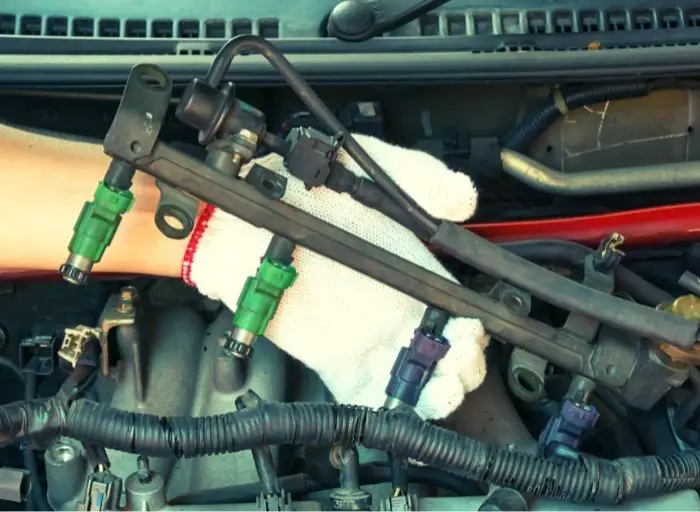
Fuel injectors that leak are a fire hazard and can cause severe and costly damage to the engine. Therefore, recognizing them is critical and addressing the issue as soon as feasible. A leaking fuel injector can be diagnosed by the right method. Let’s look at its symptoms, causes, consequences, and how to test it.
Table of Contents
Fuel Injector Leak Symptoms
Engine fuel spills are hazardous to you and the passengers. Although leaking fuel injectors are uncommon, if your car is ancient and has a high odometer reading, you should consider engine wear like o-rings. Symptoms of a leaking fuel injector include:
- Increased fuel usage
- Idling is poor and wobbly
- The smell of gasoline
- Beginnings are difficult
- Poor emission results
- Oil thinning
- Hydrolocking
What Causes The Leakage Of A Fuel Injector?
Though fuel injectors are designed to last the engine’s life, improper driving habits and maintenance might cause them to fail. Fuel injectors that leak are more common in older vehicles with heavy mileage.
According to experts, there are two basic methods for a fuel injector to leak. Either from the injector’s body or an O-ring.
If there is damage to the injector body, like rust or a crack, the injector must be replaced entirely. Damage to the injector’s body, ball, pintle, or disc seat might cause this leak. In addition, rough driving, such as abrupt stops and starts, can create damage that can lead to a leak.
O-ring leaks can result from brittle, ill-fitting, or damaged o-rings. The condition of the o-rings and poor maintenance produce these leaks, which cause parts to break down over time.
What Are the Consequences of A Leaking Fuel Injector?
1. Fuel injectors that are leaking might cause thin oil
The fuel pressure should remain at or slightly below operating pressure for a considerable time after the engine is shut off. Due to pintle, ball, or disc seat leaks, or the bottom O-ring leak on a side feed injector, fuel will leak into the intake manifold. From the manifold, fuel will flow down to the intake valves. Fuel enters the cylinder through an open intake valve, leaks through the rings, and eventually mixes with the engine oil.
Oil thinning can cause engine bearing failure and burned cylinder sidewalls. In some instances, it can even create an explosion inside the machine. The hydro lock has been reported as a result of leaking fuel injectors because too much fuel accumulated on top of the piston, preventing the engine from compressing the liquid in the cylinder when it was switched over. Hydralock can cause broken pistons, bent connecting rods, and blown head gaskets, to mention a few consequences. All of the fixes were incredibly expensive.
2. A leaking fuel injector can cause difficulty starting
A leaking fuel injector or injectors is the most common cause of problematic or challenging to start engines, especially when they are hot. This is due to a reduction in fuel rail pressure, allowing fuel to flow into the manifold and flood the spark plugs.
O-rings are utilized in both top feed and side feed fuel injectors to seal the fuel injector and the fuel rail. Fuel Injector O-rings can harden and become brittle over time, especially in older vehicles. This can lead to external and internal gasoline leaks, which should be corrected as soon as possible.
How to Check for Fuel Injector Leaks
The most common symptom when you have an externally leaking fuel injector is a ‘gas smell inside your automobile.’ This is a comprehensive guide on doing a fuel injector leak test.
What will happen if a fuel injector is leaking? For example, your fuel injectors three and four are leaking, but ones one and two are fine. As a result, no three or four injectors will spray surplus gasoline into the cylinder. Instead, the computer will communicate to the ECM, telling it to lower the amount of fuel sprayed by the fuel injectors.
Because the ECM will not recognize which injector is spewing too much fuel, it will limit the amount of fuel sprayed by all injectors. Because the ECM has lowered the amount of fuel sprayed by the non-leaking injectors, fuel flow from cylinders one and two will be insufficient.
When this occurs, your computer stores a misfire code in its memory. Codes for P0301 in cylinder 1, P0302 in cylinder 2, P0303 in cylinder 3, and P0304 in cylinder 4. It will be converted to a misfire once the computer changes the spraying rate of non-leaking injectors. There could be numerous variants from here. However, understanding how your injectors function and affect your engine is critical.
Let’s get started with step-by-step instructions.
Step 1: Start your engine and check the fuel injectors separately for leaks while idle. If there are any external leaks, it’s possible that your fuel injector O ring is to blame. If this is the issue, you’ll need to replace the broken o rings with new ones.
Step 2: Turn off the automobile and disconnect the negative connection from your battery. Unscrew the fasteners holding your air filter box out of the way (if it’s blocking you).
Step 3: Remove your throttle cable or unhook your throttle socket, depending on your automobile model. Ensure that all cables are gently removed along the way.
Step 4: Disconnect the injectors’ sockets. Remove the fuel rail with the injector remover after unbolting it. To correctly perform this test, make sure the fuel lines are left on the fuel rail so that the fuel pump can produce appropriate fuel pressure.
Step 5: Get a milliliter syringe or something similar to measure the pressure of the fuel.
Step 6: Check the voltage on the injector sockets with your multimeter. In most autos, injectors are equipped with two pins. So 3.70 and 3.89 are acceptable numbers. Above that, you don’t want to see any variations.
Step 7: Remove your fuel fuse and examine it closely; PIN 87 and 30, the primary fuel lines, will be visible. To keep the fuel going smoothly, contact the fuse.
Step 8: Run current through your injectors and check their spraying rates independently. I requested you to use a syringe with a milliliter numbering system on the body to determine the amount of gasoline entering the container during this operation. Allow the fuel to reach 30-50 milliliters; the larger the number, the more accurate the reading.
Step 9: In this testing model, it’s best to track how long each injector takes to fill the milliliter container. If you don’t have access to a milliliter container, any other container will suffice. You must, however, keep a constant eye on the spraying rate. Spraying should go without a hitch. There should be no large droplets coming out. Any injector that is pouring excessive fuel indicates that the injector is leaking.
Can You Drive With A Leaking Fuel Injector?
Because a leaky fuel injector can make it difficult to start your automobile, you may not be able to drive it, depending on the degree of the leak.
Leaking fuel might cause your engine to overheat and combust. In addition, it can potentially result in additional vehicle damage, such as a hydro-locked engine. If your automobile is still driveable, but you’re experiencing signs of a defective fuel injector, we suggest not driving and taking care of the problem as soon as possible.
Conclusion
The vehicle should not be driven if a fuel leak is observable from any fuel injection components. The issue should be addressed right now. Call your mechanic right away if you suspect your engine’s fuel injectors are leaking.
Hi there! I’m Naomi O’Colman. I’ve got years of experience working at an auto repair shop here in Texas under my belt. On top of that, ever since I was a kid I’ve been passionate about the auto industry. Since I’ve joined the team at automotivegearz.com I’ve been enthusiastically sharing my passion and insights with my readers. I’m dedicated to delivering high quality content and helping you stay up to date with the latest automotive trends and products out there!







